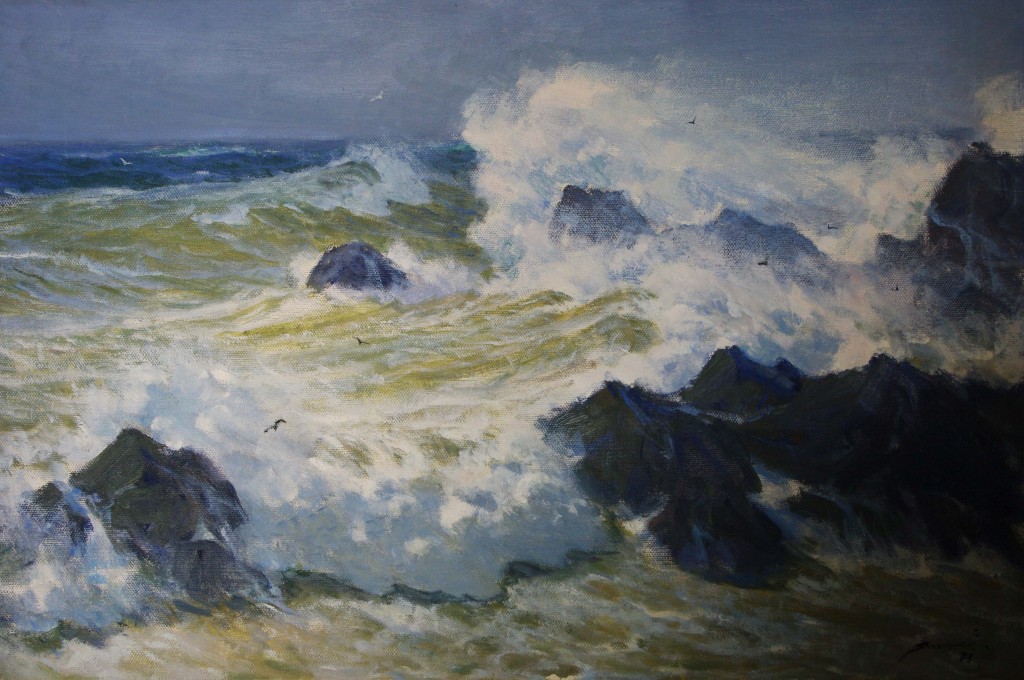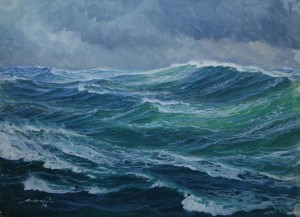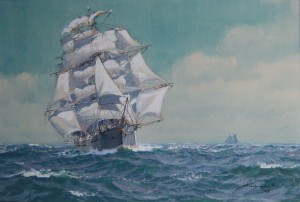Great Romanians: Dimitrie STIUBEI (1901-1986)

To paint the sea is not difficult: it is very difficult! This is why the greatest artists of all times, avoided this type of subject, which is very odd if one considers that the sea represents two thirds of the surface of the earth.
Even nations with a history and tradition intimately linked to sea faring could not describe it through painting without a compromise: that is of painting sailing boats and sea battles without painting actually the waves.
By contrast, Dimitrie Stiubei, placed the sea waves at the centre of his compositions, the open sea, towards the infinite horizon, where the sea meets the sky.
An ex naval officer Stiubei spent almost his entire life at sea. He did not become a painter by chance neither was he self-taught. He studied painting first from his mentor Jean Steriadi (1880-1986) and then as a student of the Munich Academy of Painting under Ernst Liebermann (1869-1960) and Peter Trumm (1888-1966):
Peter Trumm described him as follows:
… blessed with an extraordinary talent, a vivid intelligence and a feeling about the true essence of painting, Dimitrie Stiubei surpassed all expectations through his military education. Within a very short time he developed his artistic capacity in an amazing manner. The sum total of his oeuvre, without any doubt, is very strong indeed, especially in portrait and marine painting.
Dimitrie Stiubei exhibited extensively in Paris, Athens, Geneva, Basel, Lugano and New York. He also exhibited at the Royal Society of Marine Artists in London.
The artist was honoured with the French Légion d’honneur and in the seventies he was decorated with the Vermeille medal from the Society of Arts, Sciences and Letters.
This is only a small part of his curriculum. During his long span of life at sea he neither fought the sea nor was he awed by it, like most people: instead he loved it and spent the most beautiful moments of his life in its company.
This is how the artist was able to paint and imortalise those magic moments of intensity which the sea offers to the those who understand it.
After his retrospective exhibition in the United States, in 1970, The New York Herald Tribune called him:
‘the last and the greatest painter of the sea, of our epoch’.
NOTE: text modified from the catalogue of Dimitrie Stiubei retrospective exhibition in Italy. (original text and illustrations – Mario Ricci)








Buna ziua,
Am avut un tablou semnat de Stiubei, care mi-a disparut. Pentru a reclama la politie furtul trebuie sa-l identific. Pentru aceasta incerc sa gasesc un catalog complect cu operele lui Stiubei. Ma puteti ajuta?
Multumesc
Dumitru Mihalcea
Cluj Napoca
dmihalcea2003@yahoo.com
Domnule,
Va multumesc pentru mesaj: din nefericire nu cunosc existenta unui eventual catalog “raisonne’ al acestui artist, desi mi s-ar parea foarte util.
Incercati Muzeul (din Constanta?) care ar detine o colectie importanta al acestui pictor.
Editor
Londra
Incercati la Yacht Club Regal Roman, au editat acum cativa ani o carte despre Stiubei, poate aveti noroc.
Cel mai mare pictor “marinist” al nostru, de faima internationala. Cand a emigrat in Germania ( la ginerele sau Tiberiu Ricci) toate tablourile sale de la Muzeul Marinei, si nu numai, au fost bagate la beci, fiind repuse la locul lor de cinste abia dupa 1989. A machetat si realizat pentru Posta Romana, pana in 1968, 95 % din marcile cu tematica marina. Seria ” Prima Expozitie Marinareasca” din 1936 fiind tiparita si cu marcile nedantelate intr-un tiraj de numai 200 de serii ! Extrem de greu de gasit pe piata de filatelisti. Si sa nu uit, Stiubei a realizat prima serie de timbre cu tematica marina din istoria postei romane , in 1931, serie cu titlul ” Semicentenarul Marinei Romane ” Am avut onoarea si preivilegiul sa-l cunosc personal pe maestrul Stiubei ( Titi, cum ii ziceau apropiatii) la sfarsitul anilor ’60 in casa prietenului sau bun din Constanta, Mircea Nicolau, capitan de cursa lunga , in flota romana.